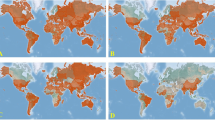Abstract
A total of 237 Plant Introduction in eleven Trifolium species were evaluated for resistance to Meloidogyne arenaria (Neal) Chitwood race 1, M. hapla Chitwood, M. incognita (Kofoid & White) Chitwood race 3, and M. javanica (Treub) Chitwood. Plants were infected with 1500 nematode eggs collected from 'Rutgers' tomato (Lycoperiscon esculentum Mill.) roots with 0.5% NaOCl. Ratings of galling severity and egg mass production were assigned to each plant 8 wk after inoculation. Host plant reaction was classified as immune, highly resistant, resistant, moderately resistant, intermediate, moderately susceptible, susceptible, and highly susceptible according to the resistance index \(RI{\text{ = }}\sqrt {{\text{(gall}}^{\text{2}} {\text{ + egg}}^{\text{2}} {\text{)}}} \). More than 95% of 171 white clover accessions were moderately to highly susceptible to all four nematodes species. The best white clover accessions were only moderately resistant to either M. arenaria (PI 291843 and PI 306286) or M. hapla (PI 100250 and PI 204930). Accessions with moderate resistance or resistance to root-knot nematodes were found among relatives of white clover, with T. ambiguum M. Bieb. exhibiting the greatest resistance level. Among the other Trifolium species evaluated, T. carolinianum Michx. PI 516273 was immune or highly resistant to all four nematode species while accessions of T. hirtum All. showed a wide range of reaction to root-knot nematodes. Identified germplasm of white clover relatives with resistance to root knot nematodes should be useful for the selection of parents in white clover breeding programs.
Similar content being viewed by others
References
Bain, D.C., 1959. Selection for resistance of white and red clover. Plant Dis. Rep. 43: 318–322.
Baltensperger, D.D., K.H. Queensberry, R.A. Dunn & M.M. Abd-Elgawad, 1985. Root-knot nematode interaction with Berseem clover and other temperate forage legumes. Crop Sci. 25: 848– 851.
Baxter, L.W.& P.B. Gibson, 1959. Effect of root-knot nematodes on the persistence of white clover. Agron. J. 51: 603–604.
Gibson, P.B., 1973. Registration of SC-1 white clover germplasm. Crop Sci. 13: 131.
Hartman, K., 1982. Enhancement technique for egg masses of the root-knot nematode with phloxine B. pp. 129–130. In: Proceed. Root-knot nematode, Meloidogyne spp. Region II. Centro Internationale de la Papa. Lima, Peru.
Hussey, R.S. & K.R. Barker, 1973. A comparison of methods of collecting inocula of Meloidogyne spp. including a new technique. Plant dis. Rep. 57: 1025–1028.
Kouamé, C.N., D.D. Baltensperger, G.M. Prine & R.A. Dunn, 1989. Screening Subterranean clover (Trifolium spp.) germplasm for resistance to Meloidogyne species. J. Nematology 21: 379–383.
Kouamé, C.N., K.H. Quesenberry & R.A. Dunn, 1997. Response to root-knot nematodes of a germplasm collection of red clover and related species. Gen. Res. and Crop Evolution. (In print).
Pederson, G.A. & G.L. Windham, 1989. Resistance to Meloidogyne incognita in Trifolium interspecific hybrids and species related to white clover. Plant Diseases 73: 567–569.
Quesenberry, K.H., D.D. Baltensperger, R.A. Dunn, C.J. Wilcox & S.R. Hardy, 1989. Selection of tolerance to root-knot nematodes in red clover. Crop Sci. 29: 62–65.
Rupert, E.A. & P.T. Evans, 1989. Embryo development after interspecific cross pollinations among species of Trifolium, section Lotoidea. Am. Soc. Agron. Abstr. p. 68.
Taylor, A.L. & J.N. Sasser, 1978. Biology, identification, and control of root-knot nematodes (Meloidogyne species). North Carolina State University Graphics, Raleigh, NC. 111 p.
Williams, E.J. Plummer & M. Phung, 1982. Cytology and fertility of Trifolium repens, T. ambiguum, T. hybridum, and interspecific hybrids. New Zealand J. Bot. 20: 115–120.
Windham, G.L. & G.A. Pederson, 1989. Aggressiveness of Meloidogyne incognita host races on white clover. Nematropica 19: 177–183.
Windham, G.L. & G.A. Pederson, 1991. Reaction of Trifolium repens cultivars and germplasm to Meloidogyne incognita. J. of Nematology Supplement 23: 593–597.
Author information
Authors and Affiliations
Rights and permissions
About this article
Cite this article
Kouamé, C.N., Quesenberry, K.H., Wofford, D.S. et al. Genetic diversity for root-knot nematode resistance in white clover and related species. Genetic Resources and Crop Evolution 45, 1–8 (1998). https://doi.org/10.1023/A:1008677918975
Issue Date:
DOI: https://doi.org/10.1023/A:1008677918975



